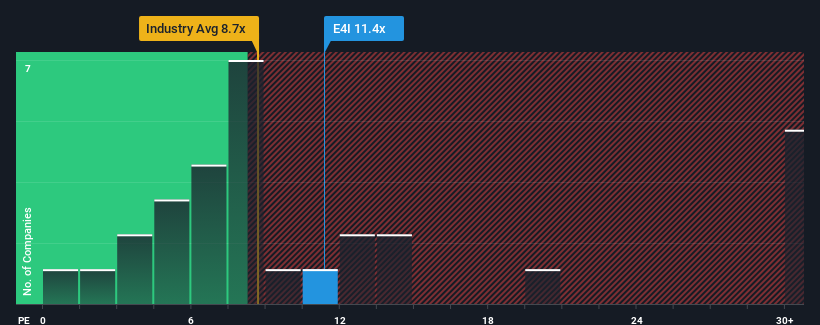- Germany
- /
- Consumer Finance
- /
- XTRA:MULT
Investors Still Aren't Entirely Convinced By Multitude P.L.C.'s (ETR:E4I) Earnings Despite 26% Price Jump
Those holding Multitude P.L.C. (ETR:E4I) shares would be relieved that the share price has rebounded 26% in the last thirty days, but it needs to keep going to repair the recent damage it has caused to investor portfolios. The last 30 days bring the annual gain to a very sharp 72%.
Even after such a large jump in price, Multitude's price-to-earnings (or "P/E") ratio of 11.4x might still make it look like a buy right now compared to the market in Germany, where around half of the companies have P/E ratios above 17x and even P/E's above 31x are quite common. Although, it's not wise to just take the P/E at face value as there may be an explanation why it's limited.
While the market has experienced earnings growth lately, Multitude's earnings have gone into reverse gear, which is not great. It seems that many are expecting the dour earnings performance to persist, which has repressed the P/E. If this is the case, then existing shareholders will probably struggle to get excited about the future direction of the share price.
See our latest analysis for Multitude

What Are Growth Metrics Telling Us About The Low P/E?
There's an inherent assumption that a company should underperform the market for P/E ratios like Multitude's to be considered reasonable.
If we review the last year of earnings, dishearteningly the company's profits fell to the tune of 18%. The last three years don't look nice either as the company has shrunk EPS by 16% in aggregate. So unfortunately, we have to acknowledge that the company has not done a great job of growing earnings over that time.
Looking ahead now, EPS is anticipated to climb by 36% each year during the coming three years according to the four analysts following the company. That's shaping up to be materially higher than the 15% each year growth forecast for the broader market.
With this information, we find it odd that Multitude is trading at a P/E lower than the market. It looks like most investors are not convinced at all that the company can achieve future growth expectations.
The Bottom Line On Multitude's P/E
Multitude's stock might have been given a solid boost, but its P/E certainly hasn't reached any great heights. It's argued the price-to-earnings ratio is an inferior measure of value within certain industries, but it can be a powerful business sentiment indicator.
Our examination of Multitude's analyst forecasts revealed that its superior earnings outlook isn't contributing to its P/E anywhere near as much as we would have predicted. When we see a strong earnings outlook with faster-than-market growth, we assume potential risks are what might be placing significant pressure on the P/E ratio. It appears many are indeed anticipating earnings instability, because these conditions should normally provide a boost to the share price.
There are also other vital risk factors to consider and we've discovered 3 warning signs for Multitude (1 is a bit unpleasant!) that you should be aware of before investing here.
If you're unsure about the strength of Multitude's business, why not explore our interactive list of stocks with solid business fundamentals for some other companies you may have missed.
New: Manage All Your Stock Portfolios in One Place
We've created the ultimate portfolio companion for stock investors, and it's free.
• Connect an unlimited number of Portfolios and see your total in one currency
• Be alerted to new Warning Signs or Risks via email or mobile
• Track the Fair Value of your stocks
Have feedback on this article? Concerned about the content? Get in touch with us directly. Alternatively, email editorial-team (at) simplywallst.com.
This article by Simply Wall St is general in nature. We provide commentary based on historical data and analyst forecasts only using an unbiased methodology and our articles are not intended to be financial advice. It does not constitute a recommendation to buy or sell any stock, and does not take account of your objectives, or your financial situation. We aim to bring you long-term focused analysis driven by fundamental data. Note that our analysis may not factor in the latest price-sensitive company announcements or qualitative material. Simply Wall St has no position in any stocks mentioned.
About XTRA:MULT
Multitude
Provides digital lending and online banking services in Finland.
Undervalued with solid track record and pays a dividend.
Market Insights
Community Narratives




